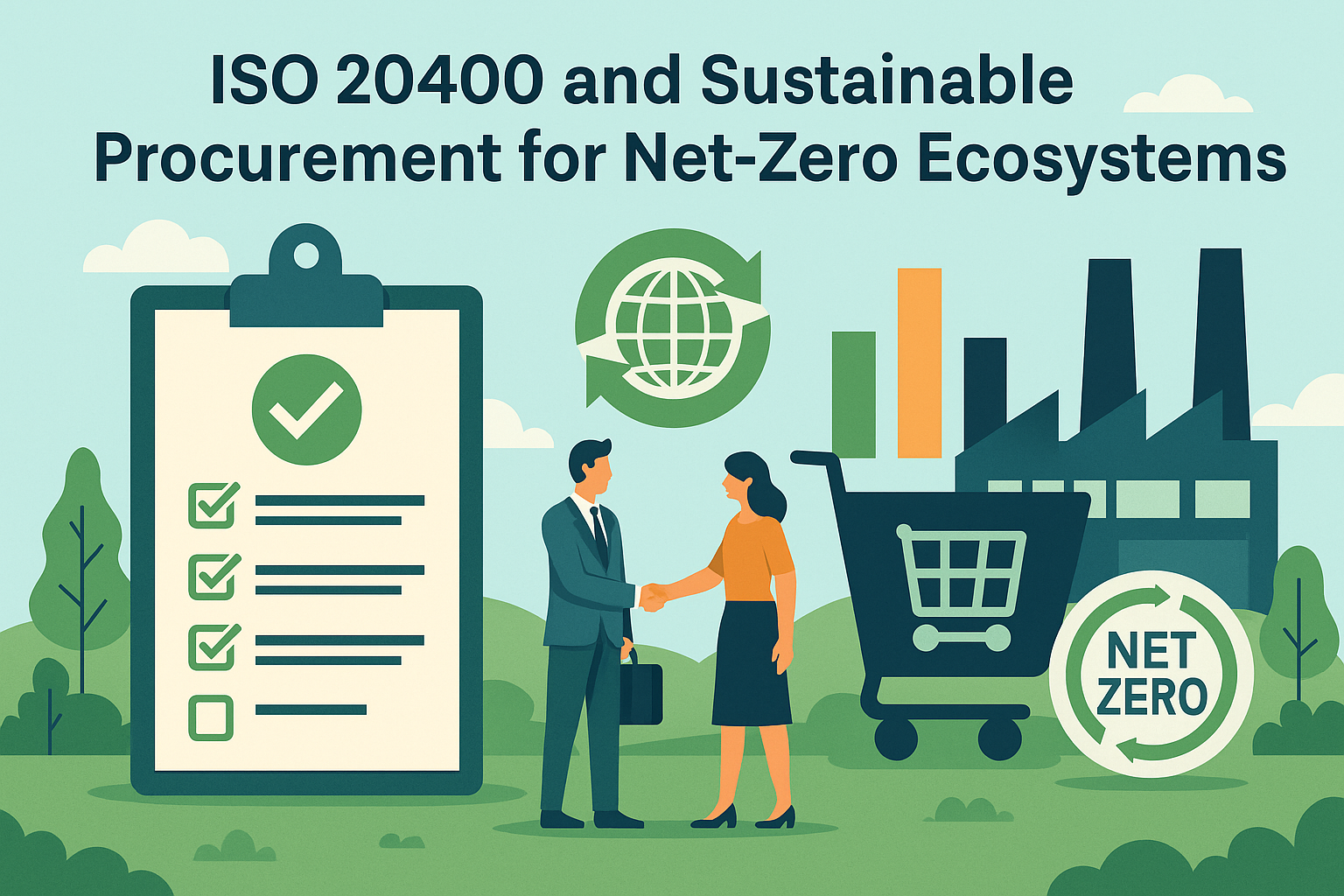
Introduction
Global sustainability targets – such as limiting warming to 1.5°C by 2050 – are now mainstream business drivers. Achieving net-zero emissions requires not only cutting an organization’s direct (Scope 1 and 2) emissions, but also transforming its supply chain. In fact, procurement accounts for the lion’s share of many companies’ footprints: studies find that roughly 70–99% of corporate greenhouse gas emissions come from the value chain (Scope 3). Simply put, buying decisions today determine the carbon emissions of tomorrow.
As governments and markets tighten regulations on emissions (e.g. the EU’s Corporate Sustainability Reporting Directive mandates detailed Scope 3 disclosure) and stakeholders demand climate action, procurement becomes a strategic lever for mitigation. Sustainable procurement ensures that environmental and social criteria guide purchasing alongside cost and quality. ISO 20400:2017 is the first international standard dedicated to this, providing guidance (not certification) for integrating sustainability into procurement functions of any organization. This blog explores ISO 20400’s role in the net-zero transition. We first outline the standard’s scope and principles, then show how it drives emission tracking and decarbonization planning (including scenario analysis), and finally discuss how Emitrix’s platform can put these ideas into practice through automation and AI-enabled supplier engagement
ISO 20400 Scope and Purpose
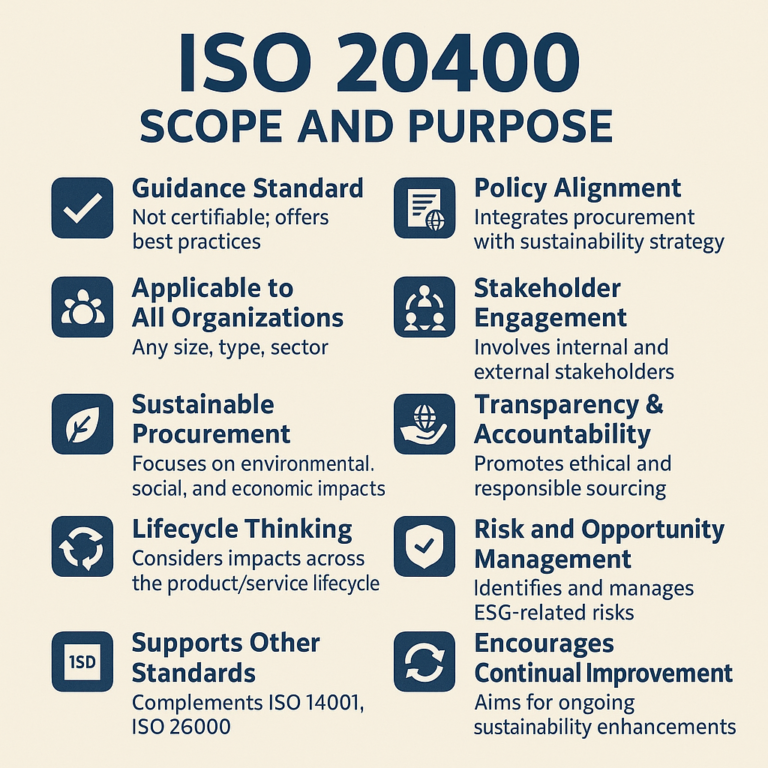
ISO 20400:2017 was published by the International Organization for Standardization to help organizations of all sizes “integrate sustainability within procurement”. Its scope covers the entire procurement lifecycle – from policy setting and sourcing strategy to supplier evaluation and contract management – embedding sustainable governance at every step. The standard emphasizes materiality and lifecycle thinking: buyers are urged to consider environmental and social impacts “across the entire life cycle” of goods and services. In effect, procurement decisions become a tool for reducing a company’s overall footprint and supporting its sustainability goals.
Importantly, ISO 20400 is a guidance document, not a certification standard. It does not impose strict requirements or require third-party audits. Rather, it outlines principles and processes: for example, aligning procurement policy with sustainability strategy; organizing the procurement team to champion sustainability; and integrating social, environmental and economic criteria into tendering and supplier selection. By doing so, it complements broader standards like ISO 26000 (social responsibility) and ISO 14001 (environmental management), with a specific focus on the purchasing function.
In summary, ISO 20400 aims to transform procurement from a purely cost-driven activity into a value-driven process. Companies using the standard learn to balance traditional concerns (price, quality, risk) with impacts on climate, natural resources, labor rights and community welfare. This holistic approach turns procurement into a proactive engine for sustainability, rather than a blind spot.
Key Concepts and Principles

At its core, ISO 20400 rests on clear sustainability principles and pillars. The standard’s fundamentals include accountability for environmental/social impacts, transparency in decision-making, and ethical behaviour throughout sourcing. Buyers must respect human rights and stakeholder interests, abide by relevant laws, and give fair opportunity to diverse suppliers. Crucially, the standard calls for integration of sustainability criteria into every procurement stage – from the initial need assessment (challenging whether a purchase is truly necessary) to whole-life costing and continual improvement.
The three pillars of sustainable procurement – environmental, social, and governance (ESG) factors – drive these principles. For example, environmental stewardship means minimizing waste, emissions and resource use in supply chains; social responsibility means ensuring fair labor practices and community benefits; and governance means implementing fair trade and anti-corruption measures. By interlinking these pillars, ISO 20400 helps organizations “identify and address the ESG risks and opportunities” in their supply chains. In practice, this leads to actions such as: choosing low-carbon materials, auditing supplier labor conditions, and requiring suppliers to adhere to ethical standards.
Risk Management is a central theme. Companies increasingly recognize that unsustainable supply chains pose financial, regulatory and reputational risks. Indeed, the CDP reports that firms face up to $120 billion of potential losses from climate and sustainability risks in their supply chains. ISO 20400 guides teams to map and prioritize such risks: for instance, using a “heatmap” approach to flag high-emission or high-impact categories, and then targeting them for action. Rigorous supplier assessments, verification and scenario analysis (discussed below) become standard practice.
Supplier Engagement is equally essential. Unlike traditional procurement, sustainable procurement views suppliers as partners in change. ISO 20400 encourages transparent communication of expectations and incentives for performance. By fostering collaboration, buyers can co-develop low-impact products or technology innovations with their suppliers. For example, buyers might offer long-term contracts or preferred status to suppliers who invest in green technology. This shifts buyer–seller relations from adversarial to collaborative, which is critical because suppliers often control most of the emissions (see below
Emissions Tracking, Decarbonization Planning, and Scenario Analysis
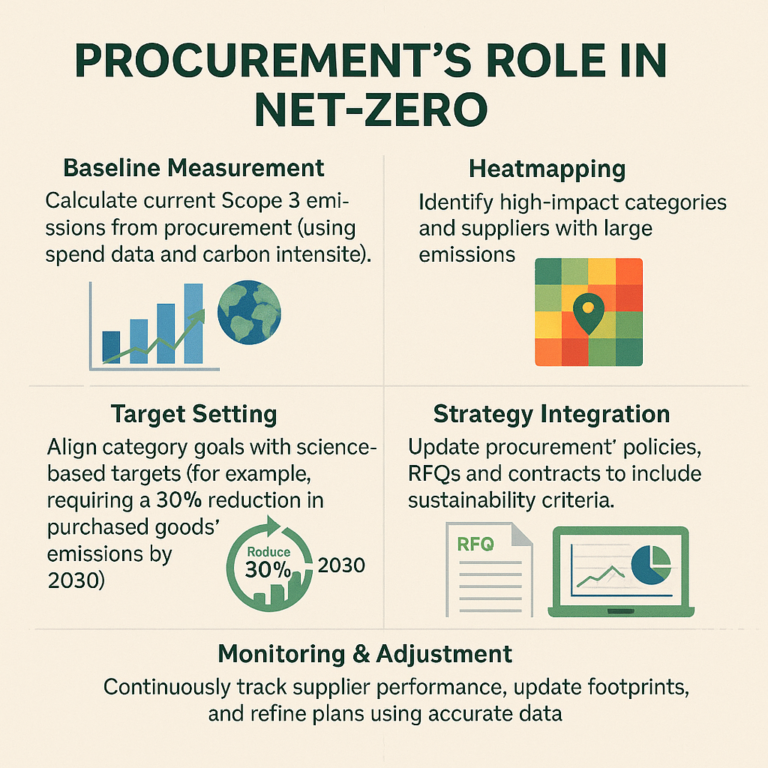
A powerful feature of sustainable procurement is its explicit connection to carbon management. ISO 20400 itself does not define detailed carbon accounting, but it provides the framework to incorporate it. Organizations are encouraged to measure and reduce emissions across all scopes: direct (Scope 1), purchased energy (Scope 2), and especially supply chain (Scope 3). Since procurement largely affects Scope 3 – often 70–99% of a company’s emissions – teams must build capabilities to track these indirect emissions.
Practically, this means linking purchases to emissions factors or supplier data. For example, procurement can collect product carbon footprints (PCFs) or use emissions calculators to estimate the footprint of purchases. The standard’s life-cycle focus dovetails with greenhouse gas accounting: it prompts procurement to consider emissions during production, transportation, use and end-of-life of goods. In many cases this reveals hotspots – such as concrete or plastics in construction, or electronics in IT – where interventions (like material substitution or efficiency improvements) yield big emissions cuts.
Once emissions are mapped, decarbonization planning and scenario analysis come into play. Leading companies now set science-based targets (e.g. halving emissions by 2030, net-zero by 2050) and translate these into procurement strategies. ISO 20400 helps embed these targets into procurement policy and supplier contracts. Scenario analysis – a key recommendation in climate risk frameworks – can be applied to procurement by modeling different future policies or market conditions (e.g. carbon price hikes) and testing how supply choices hold up. Advanced tools can even run “what-if” analyses on supply chain restructuring.
In practice, procurement’s role in net-zero looks like this:
Baseline Measurement: Calculate current Scope 3 emissions from procurement (using spend data and carbon intensities).
Heatmapping: Identify high-impact categories and suppliers with large emissions.
Target Setting: Align category goals with science-based targets (for example, requiring a 30% reduction in purchased goods’ emissions by 2030).
Strategy Integration: Update procurement policies, RFQs and contracts to include sustainability criteria.
Monitoring & Adjustment: Continuously track supplier performance, update footprints, and refine plans using accurate data.
By following such steps, procurement teams can transform emissions goals into concrete purchasing decisions. Engaging suppliers in this process is crucial: many sustainability leaders work directly with vendors on energy efficiency, renewable energy purchase, and cleaner production methods.
Operationalizing ISO 20400 with Emitrix’s Platform
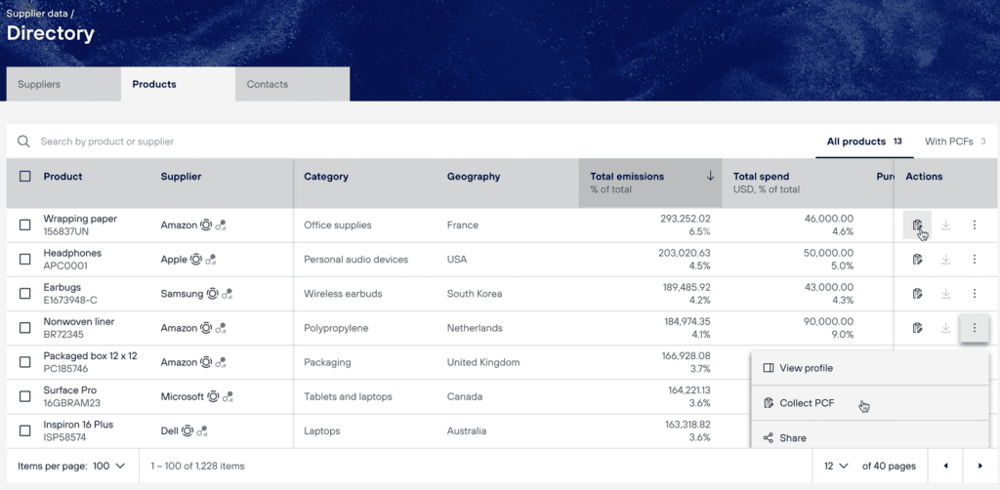
Modern software platforms are key to scaling sustainable procurement. Emitrix provides an automated, AI-powered platform that connects procurement and sustainability teams with their suppliers. The screenshot above shows a supplier directory where products are listed alongside their emissions and spend. This kind of dashboard gives buyers a clear view of where emissions lie (and how much they spend), enabling data-driven sourcing decisions.
Emitrix’s tools streamline the ISO 20400 process in several ways. First, they automate emissions tracking. By ingesting procurement and spend data, the platform automatically assigns emissions factors at the product or category level, generating baseline Scope 3 inventories without endless manual work. The platform’s AI (including generative AI matching of bills-of-material) accelerates calculation of product carbon footprints – as little as a few minutes per product. This addresses the uncertainty inherent in Scope 3 accounting by cross-referencing millions of data points (supplier data, published life-cycle analyses, industry averages) to produce credible, comparable footprints.
Second, Emitrix embeds supplier engagement. Procurement teams can invite suppliers onto the platform to share emissions data and improvement plans. In fact, Emitrix offers a free version of its supplier app, equipping vendors with carbon footprint calculators and scorecards so they can start reducing their own emissions at no cost. This mutual support means buyers are not simply demanding numbers – they are enabling suppliers to deliver them. As one Emitrix study notes, a collaborative engagement strategy gives both parties the data needed for compliance and the means to act on it.
Third, Emitrix provides reporting and decision support aligned with ISO 20400’s goals. The platform can generate reports on procurement sustainability metrics, scenario analyses and progress toward decarbonization targets. For example, it can highlight “carbon hotspots” by spend category (e.g. showing that 50% of emissions come from a few major suppliers). It also helps manage contracts: buyers can include emission-reduction clauses or require suppliers to meet certain benchmarks, and then monitor compliance automatically. By integrating ESG risk screening and sustainability KPIs into the procurement workflow (for example, adding emissions criteria to RFPs and supplier scorecards), the platform turns policy into practice.
In summary, Emitrix’s platform operationalizes ISO 20400 through automation, AI and transparency. It makes sustainable procurement tangible: procurement officers can “see” the emissions implications of each decision, track whether suppliers are meeting targets, and use data analytics to plan under different decarbonization scenarios. This creates a reliable, transparent, and impactful sustainability ecosystem – precisely the outcome that Emitrix’s ongoing research journey is building toward.

Case for Adoption: Value and Alignment with Global Goals
Sustainable procurement, guided by ISO 20400, is not just good for the planet – it is good for business strategy. Leading companies and governments are explicitly aligning procurement with climate goals. For instance, the World Economic Forum’s First Movers Coalition and national policies (like the UK’s Net Zero 2050 target and accompanying green procurement rules) recognize that buyer-driven demand is needed to reach net zero. In practice, publicly funded programs now require suppliers to set carbon reduction targets – for example, the UK National Health Service mandates Scope 1, 2 and some Scope 3 targets for suppliers as part of its procurement contracts.
The business benefits of adopting ISO 20400-aligned procurement are well documented. Companies that integrate sustainability into sourcing can mitigate risk – reducing exposure to supply-chain disruptions, resource shortages or regulatory fines. They also enhance brand and market position: customers and investors increasingly favor firms with clean, ethical supply chains. A study by ASUS noted that sustainable procurement enables firms to safeguard environmental impacts, uphold labor standards, and gain competitive advantage. In addition, aligning with standards like ISO 20400 and reporting requirements (CSRD, the EU Green Deal, etc.) improves compliance and corporate reputation.
From a bottom-line view, sustainable procurement can even cut costs long-term. By focusing on resource efficiency and waste reduction, companies often save on energy and materials. Emitrix’s research highlights that procurement can identify lower-carbon products that are also cheaper to operate – for example, choosing energy-efficient equipment that reduces both emissions and utility bills. Over time, supply-chain collaboration also stimulates innovation: buyers reward suppliers that develop greener technologies, creating new business opportunities.
Most importantly, sustainable procurement helps align a company’s operational goals with global climate targets. The Paris Agreement and UN Sustainable Development Goals set ambitious emissions cuts (roughly a 50% cut by 2030 and net zero by 2050). If companies are to meet their science-based targets, they must decarbonize supply chains – often by up to 90% over coming decades. Since Scope 3 typically accounts for about 75% of a firm’s footprint, procurement is the strategic lever for hitting these targets. By following ISO 20400, businesses make their purchasing decisions directly contribute to these global commitments.
In short, sustainable procurement transforms a company’s biggest climate challenge – its supply chain – into a pathway for achieving net-zero. The organizations that adopt ISO 20400 early gain a “seat at the table” when it comes to defining the low-carbon economy of the future.
Conclusion
ISO 20400:2017 offers a clear roadmap for making procurement a driver of sustainability. By embedding its principles – accountability, transparency, lifecycle stewardship and stakeholder engagement – into purchasing processes, organizations can systematically address the climate and social risks in their supply chains. Tracking Scope 1, 2 and 3 emissions, setting decarbonization plans and even applying scenario analyses become part of routine procurement practice. Crucially, supplier relationships shift from transactional to strategic partnerships: buyers work with vendors to innovate, reduce emissions and build shared value.
Technology underpins this transformation. A platform like Emitrix’s leverages automation and AI to make ISO 20400 actionable at scale: it streamlines emissions data collection, powers AI-driven reporting, and keeps suppliers engaged and accountable. The embedded image above is just one example of how data can be visualized – showing emissions by product category and highlighting hotspots. In our ongoing research journey, Emitrix continues to refine these tools and practices, building a reliable, transparent sustainability ecosystem for procurement.
Sustainable procurement is not a cost – it is a strategic investment. When businesses align their buying practices with global climate objectives and social responsibility, they unlock resilience and growth opportunities. As this paper has shown, ISO 20400 is a powerful guide for this journey. With proper implementation and the support of solutions like Emitrix’s platform, organizations can meet shareholder and stakeholder expectations, comply with emerging regulations, and most importantly, play their part in securing a net-zero future for all.


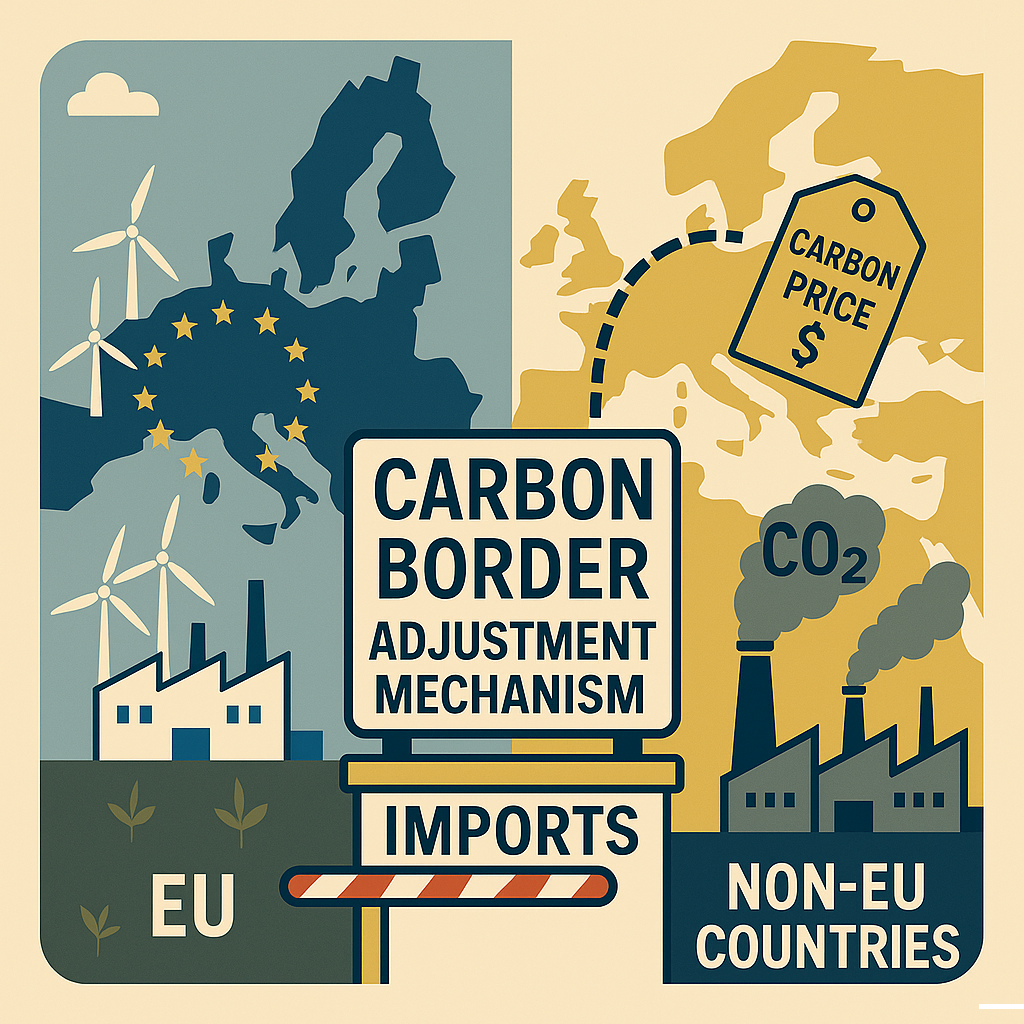
I have been absent for some time, but now I remember why I used to love this site. Thank you, I will try and check back more frequently. How frequently you update your website?